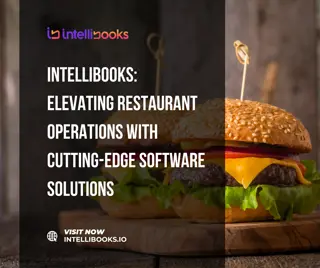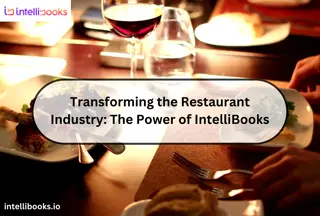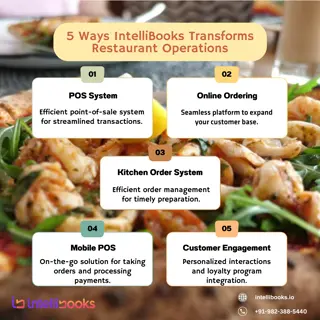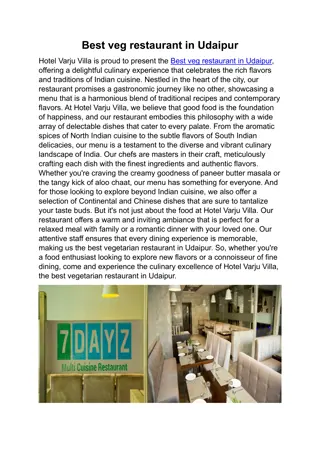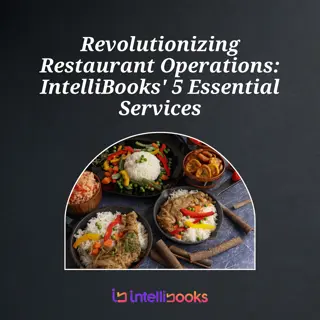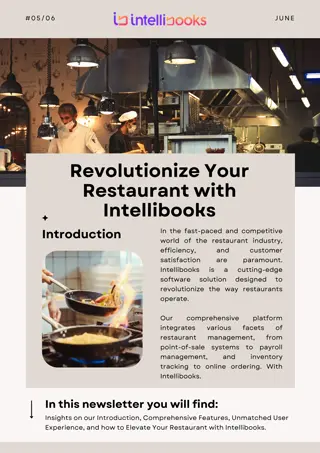Changing Dynamics of Restaurant Industry
Technology is revolutionizing the way restaurants engage with customers, from online ordering to delivery services and automation. Millennials lead the shift towards tech-driven dining experiences, influencing where they eat based on technology offerings. With the rise of mobile ordering and delivery options, restaurants are adapting to meet evolving consumer preferences and trends. The integration of AI and robotics is reshaping operations, improving efficiency and customer service. Stay tuned for the latest changes in the restaurant landscape.
Download Presentation

Please find below an Image/Link to download the presentation.
The content on the website is provided AS IS for your information and personal use only. It may not be sold, licensed, or shared on other websites without obtaining consent from the author.If you encounter any issues during the download, it is possible that the publisher has removed the file from their server.
You are allowed to download the files provided on this website for personal or commercial use, subject to the condition that they are used lawfully. All files are the property of their respective owners.
The content on the website is provided AS IS for your information and personal use only. It may not be sold, licensed, or shared on other websites without obtaining consent from the author.
E N D
Presentation Transcript
Technology Is Changing Consumers Interactions with Restaurants Technology is changing restaurants and their relationship with their customers. A 2017 survey found that 42% of Millennials, compared to 18% of Baby Boomers, said technology was very or extremely influential about whether they visited a restaurant. The Alix Partners survey also revealed that 42% of restaurant patrons did not use mobile technologies while 35% said restaurants offering free Wi-Fi service was much more important. Not surprisingly, Millennials are the largest group to use the Internet to find the best restaurant deals, at 58%, but Gen Xers and diners with kids, at 57% each, were the largest groups to look for coupons/offers online for restaurants.
Online Ordering is Increasing, Especially on Mobile According to The NDP Group, restaurant orders via mobile apps, text messages and the Internet increased 18% during 2016, which translated into 1.9 billion foodservice visits. As might be expected, half of all digital orders are for dinner and families with children account for 35% of orders. An above-average number of online orders are from Millennials and consumers with higher household incomes. Twice as many digital orders are based on a promotion and most (29%) of those promotions are a coupon. Discounted prices, daily specials and combined-item specials were also significant drivers of digital orders.
Delivery and Delivery Technology Becoming Competitive Necessities Although The NPD Group reported that restaurant deliveries only accounted for 3% of total restaurant transactions for the 12 months ending June 2017, the investment firm Cowen forecasts a 79% increase, from $43 billion during 2017 to $76 billion by 2022. Cowen also reported that almost half of all deliveries were implemented online and that online deliveries will increase from $20 billion for 2017 to $55 billion by 2022. The food delivery boom is driving the creation of virtual restaurants, which offer their menus only for delivery. One model utilizes an app and manages the entire process while the second model relies on a third-party delivery service, such as Grubhub.
An Appetite for Automation Automation, in the form of artificial intelligence and robotics, is expected to impact significantly the restaurant industry, as it will for most industries. For example, many restaurants are already using chatbots for online ordering. Some major chains, such as Chili s, Applebee s, Buffalo Wild Wings and Olive Garden, have implemented tableside and tablet kiosks while Wendy s and McDonald s are taking this trend a step further with standalone kiosks. Few, if any, restaurants are fully automated yet. Front-of-the-house automation is operating at Eatsa, a San Francisco fast-food chain, while CaliBurger and Miso Robotics have invested in the development of Flippy, which automatically flips burgers.
TV and Digital Advertising Are Restaurants Meal Ticket Although TV advertising has traditionally been used to drive foot traffic, it is now part of a critical complementary ad strategy for restaurants that are adopting new technologies, as TV can also drive digital activities, such as search, Web traffic and app use. Studies have indicated that TV influences branded search by as much as 80%, there is a direct correlation between TV spend and Website traffic, and TV commercials generated a 56% to 74% uplift in app installations. In-store digital signage, such as menu boards and wall displays with current promotions, and entertainment technologies, such as games, infotainment and sports, can motivate customers to remain in a restaurant longer.
Advertising Strategies As restaurants introduce more technology into their operations, whether in-store or online, they should use TV to brand and differentiate themselves from their tech-lite competitors, and use commercials content to drive viewers to their Website or app coupons/specials. Restaurants can also use TV branding to offer a coupon or limited special for consumers who install their app or a third- party s online ordering and/or delivery app. Restaurant TV spots should avoid the typical view of the exterior or interior of the restaurant and, instead, feature the chef/head cook on camera explaining his or her style, new menu ideas and how he or she locally sources ingredients.
New Media Strategies Restaurants with a reservation service via their Website, a mobile app or third-party provider can assign a wait person for each reservation, and then have him or her record a personalized video of introduction that is sent with the reservation confirmation. With more major restaurant chains utilizing various digital channels, such as apps, online ordering and delivery, it is critical for locally- owned restaurants to review and upgrade their listings on Google, Yelp, Zomato and similar sites, at least quarterly. Based on The Media Audit survey examples in the Profiler, restaurants should use TV stations Website regularly and display ads with coupons/specials aimed specifically at adults 18 49 and adults 50+.



